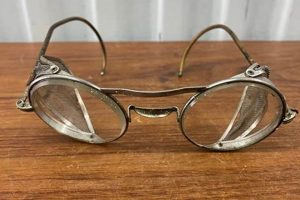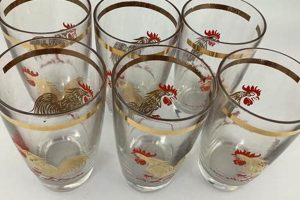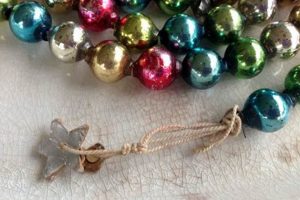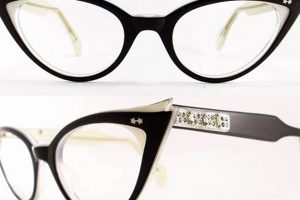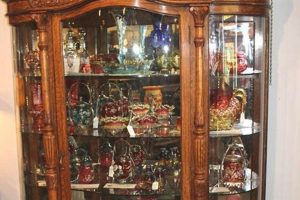These decorative hardware elements, commonly used on furniture and cabinetry from past eras, are crafted from glass and serve as pulls for accessing enclosed spaces. An example includes a Depression-era cabinet featuring intricately molded clear hardware instead of modern metal alternatives.
Their appeal lies in their aesthetic contribution, adding character and often a touch of elegance to furnishings. Historically, they reflect design trends and manufacturing techniques of specific periods, providing insights into past lifestyles and artisanal practices. Furthermore, utilizing these restored or original fittings can enhance the value and authenticity of antique pieces.
The following will delve into the characteristics that define authentic examples, the range of styles available, considerations for sourcing and restoration, and their impact on interior design.
Essential Guidance on Identifying and Utilizing Glass Cabinet Hardware from Previous Eras
This section provides concise advice for evaluating, acquiring, and incorporating glass fittings from bygone eras into interior spaces.
Tip 1: Verify Authenticity: Examine for manufacturing imperfections common in older glass production, such as bubbles or slight irregularities. Perfectly uniform pieces may indicate modern reproductions.
Tip 2: Assess Condition Carefully: Scrutinize for chips, cracks, or significant discoloration. Minor wear is acceptable, but structural damage can compromise functionality and value.
Tip 3: Research Period Styles: Familiarize yourself with designs prevalent in different eras (e.g., Art Deco, Victorian) to ensure stylistic consistency with your project.
Tip 4: Consider Mounting Hardware: Inspect the accompanying screws and fixtures; original hardware can enhance authenticity but may require replacement if corroded or incompatible.
Tip 5: Clean Gently: Use mild soap and water for cleaning; avoid abrasive cleaners that could scratch or dull the glass surface.
Tip 6: Ensure Proper Fit: Verify that the dimensions are appropriate for the cabinet or drawer; oversized or undersized elements can detract from the overall appearance.
Tip 7: Integrate with Design Scheme: Select finishes and colors that complement the surrounding decor; consider the overall aesthetic you are aiming to achieve.
Careful attention to these factors will aid in the selection and preservation of visually appealing and historically relevant glass cabinet embellishments.
The subsequent section will explore specific case studies demonstrating successful integration of these items into various design contexts.
1. Material Composition
Material composition is a primary determinant of value, authenticity, and aesthetic appeal in hardware designed to adorn furniture and cabinetry from previous eras. The type of glass used, manufacturing techniques employed, and any added components critically define the artifact.
- Glass Type
Different glass types, such as lead crystal, soda-lime glass, or Depression-era glass, exhibit varying refractive properties and durability. Lead crystal, for example, is known for its clarity and brilliance, often appearing in higher-end, older fixtures. Soda-lime glass, more common, is less expensive to produce and generally found in simpler designs. The specific glass type offers clues to the items origin and intended market.
- Manufacturing Techniques
Hand-blown glass, pressed glass, and molded glass represent distinct manufacturing methods, each leaving unique visual traces. Hand-blown elements often display slight irregularities, reflecting the artisanal process. Pressed glass allows for detailed patterns and uniform shapes, characteristic of mass production during the Victorian era. Molded glass combines aspects of both, enabling complex designs at a moderate cost. The method used contributes significantly to the hardwares visual characteristics and historical significance.
- Color and Additives
The addition of minerals during the glassmaking process imparts color. Cobalt creates blue hues, manganese produces purple, and uranium yields a distinctive yellow-green fluorescence under UV light. These color variations influenced design trends and aesthetic preferences throughout history. The presence of specific colorants can assist in dating and authenticating the hardware. For instance, uranium glass was particularly popular during the early 20th century.
- Impurities and Inclusions
The presence of bubbles, striations, or other imperfections within the glass can indicate age and authenticity. While modern manufacturing strives for flawlessness, historical glass often contains these irregularities as a consequence of less refined processes. These inclusions do not necessarily detract from value; in fact, they often serve as evidence of the item’s vintage origin.
The characteristics of these decorative glass elements are intimately linked to their material composition. Variations in glass type, manufacturing techniques, coloration, and the presence of imperfections offer critical insights into their history and aesthetic qualities. Understanding these nuances enables discerning collectors and designers to accurately assess and appropriately utilize these artifacts.
2. Era of Origin
The period in which these cabinet accessories were produced significantly influences their style, material, and overall value. Identifying the era of origin provides critical context for understanding design trends and manufacturing capabilities of the time, directly impacting acquisition and restoration decisions.
- Victorian Era (1837-1901)
Glass fittings from this period are characterized by elaborate designs, often incorporating floral motifs, faceted surfaces, and the use of colored glass, particularly ruby or emerald hues. Examples include knobs with intricate floral patterns or those mimicking cut gemstones. Their presence indicates a preference for ornate decoration and reflects the era’s emphasis on opulence and craftsmanship.
- Art Deco Era (1920s-1930s)
Streamlined geometric shapes, bold colors, and the use of Bakelite accents are hallmarks of Art Deco hardware. Symmetrical patterns and stepped designs are also common. An example would be a clear glass with an octagonal base or one featuring an embedded geometric design. This aesthetic reflects a move towards modernism and a rejection of Victorian excess.
- Depression Era (1930s)
These commonly features clear or lightly colored (often pink or green) pressed glass with simple, functional designs. Due to economic constraints, ornamentation was minimized. A simple, round, clear knob would be typical. The practicality of these items reflects the economic hardships of the time.
- Mid-Century Modern Era (1945-1960s)
This style often features sleek, minimalist designs, with an emphasis on form and functionality. Colors are typically muted, with a focus on clear glass or subtle tints. A simple, domed knob exemplifies this aesthetic. The style reflects a broader trend towards simplicity and functionalism in design following World War II.
Consideration of the era of origin provides a framework for appreciating the stylistic evolution and historical context of these artifacts. Each period contributes unique design elements and manufacturing techniques, thereby influencing their identification, valuation, and application within interior design projects. Understanding the historical provenance is vital for preserving their integrity and ensuring their appropriate integration into contemporary spaces.
3. Design Variety
The characteristic of design variety within the realm of glass hardware significantly impacts their aesthetic appeal and historical relevance. The diverse range of shapes, colors, patterns, and manufacturing techniques employed throughout different periods has resulted in a wide array of available options. This variety stems from evolving artistic tastes, technological advancements in glass production, and the varying functional requirements of furniture and cabinetry across time. For example, the intricate floral patterns of Victorian-era elements stand in stark contrast to the streamlined geometric forms prevalent during the Art Deco period. This variation allows for tailored selection to complement specific design styles, enhancing the authenticity and visual coherence of restoration or interior design projects.
Understanding design variety holds practical significance for collectors, restorers, and interior designers. Accurate identification of a hardware item’s design origins facilitates proper matching of replacements for damaged or missing pieces, ensuring consistency in restoration efforts. Furthermore, this knowledge enables informed decisions regarding the integration of hardware into contemporary spaces, allowing designers to strategically utilize historical elements to create desired aesthetic effects. A clear glass knob from the Depression Era, for instance, can contribute to a minimalist aesthetic, while a colored and faceted Victorian-era one can add a touch of ornate elegance.
In conclusion, the breadth of design variety associated with these glass elements is integral to their value and versatility. Recognizing and appreciating this diversity is crucial for accurate identification, appropriate restoration, and strategic application in interior design. While challenges exist in attributing specific origins due to variations in regional production and stylistic overlap, a thorough understanding of design trends and manufacturing techniques across different historical periods remains essential for achieving optimal results.
4. Hardware Condition
The physical state significantly influences both the aesthetic and functional value of vintage glass cupboard knobs. Factors such as damage, wear, and alterations from the original state directly impact their desirability and suitability for use. Careful assessment of the condition is crucial for informed acquisition and appropriate restoration.
- Cracks and Chips
The presence of cracks or chips compromises the structural integrity and aesthetic appeal. Cracks can propagate over time, leading to further breakage. Chips, while seemingly minor, detract from the original form and may indicate previous impact damage. For example, a hairline fracture across the face of a knob significantly diminishes its collectible value and increases the risk of breakage during normal use. The extent and location of such damage are critical determinants in evaluating condition.
- Discoloration and Cloudiness
Over time, exposure to sunlight, humidity, and cleaning agents can cause discoloration or cloudiness in the glass. This reduces the transparency and brilliance, obscuring any internal designs or patterns. For example, clear glass knobs may develop a yellowish tint, while colored glass may fade or become uneven in tone. Assessing the severity and uniformity of discoloration is important, as minor discoloration may be reversible with careful cleaning, while significant cloudiness may be irreparable.
- Metal Component Condition
Many examples incorporate metal components such as screws, shanks, or mounting plates. The condition of these metal parts is equally important. Corrosion, rust, or stripped threads can compromise the stability and functionality of the entire piece. For example, a corroded screw may be impossible to remove without damaging the glass, while stripped threads prevent secure attachment to the cabinet. Examination of the metal components is therefore an essential part of assessing overall hardware condition.
- Alterations and Repairs
Previous attempts at repair or modification can significantly impact the value and authenticity. Inexpert repairs, such as the use of inappropriate adhesives or mismatched replacement parts, can detract from the original design and potentially cause further damage. For example, using epoxy to reattach a broken piece may create a visually unappealing and structurally weak bond. Identifying and evaluating any alterations or repairs is crucial for understanding the history and current state of the hardware.
In summary, a thorough evaluation of hardware condition, encompassing glass integrity, discoloration, metal component status, and any alterations, is paramount when considering vintage glass cupboard knobs. Accurate assessment ensures informed decisions regarding acquisition, restoration, and appropriate application, preserving their historical value and functional utility. Recognizing the various facets of condition allows for informed appreciation and responsible stewardship of these decorative artifacts.
5. Mounting Style
The method by which vintage glass cupboard knobs are affixed to cabinetry directly influences their functionality, aesthetic presentation, and long-term stability. An understanding of various mounting styles is essential for both restoration efforts and informed selection for appropriate application.
- Threaded Shank
This mounting style utilizes a metal shank embedded within the glass, featuring external threads to accommodate a nut on the interior of the cabinet door or drawer. The threaded shank provides a secure and adjustable attachment, allowing for variations in door thickness. Common in earlier designs, this style requires careful matching of thread size and pitch to ensure compatibility. For example, a Victorian-era knob might utilize a fine thread, whereas a Depression-era one might have a coarser thread.
- Bolt-Through
A bolt-through configuration involves a hole drilled through the knob, accommodating a bolt that passes through the cabinet door and is secured with a nut on the opposite side. This offers robust attachment, particularly suitable for heavier glass knobs or those subjected to frequent use. This style frequently utilizes a decorative washer or escutcheon on the exterior side of the cabinet for an enhanced aesthetic. Identifying the appropriate bolt length is critical for secure mounting without protruding excessively.
- Surface Mount with Screw
This style features a flat base on the knob with a countersunk hole for accepting a screw. The screw passes directly through the base and into the cabinet door. This method offers a simple and direct attachment, suitable for lighter-weight knobs and thinner cabinet doors. For instance, some Art Deco examples employ this mounting style for their clean and minimalist design. Careful selection of screw length is crucial to avoid protruding through the interior surface of the cabinet.
- Adhesive Mounting
Though less common in original vintage installations, adhesive mounting may be encountered in later modifications or repairs. This involves using an adhesive compound to attach the knob directly to the cabinet door. While offering a quick and easy solution, adhesive mounting provides a less secure and permanent attachment compared to mechanical methods. This method is generally not recommended for valuable or frequently used hardware. The type of adhesive used can also affect the glass surface over time.
The choice of mounting style directly affects the ease of installation, the stability of the attached hardware, and the overall aesthetic integration with the cabinetry. Understanding the nuances of each style enables informed decisions regarding selection, restoration, and appropriate application, ensuring the longevity and visual harmony of these decorative fittings.
Frequently Asked Questions
This section addresses common inquiries regarding these decorative hardware items, providing clarity on aspects of identification, restoration, and appropriate utilization.
Question 1: How can one distinguish authentic vintage glass cupboard knobs from modern reproductions?
Authentic pieces often exhibit subtle imperfections inherent in older manufacturing processes, such as minute bubbles or slight variations in color. Modern reproductions typically possess a uniform perfection lacking in genuinely old items. Furthermore, an examination of the mounting hardware and the presence of wear consistent with age can aid in differentiating authentic items.
Question 2: What are the most common types of damage encountered in vintage glass cupboard knobs, and how do they affect value?
Chips, cracks, and discoloration are prevalent forms of damage. The presence and extent of such damage significantly reduce the value, with larger cracks and substantial discoloration resulting in more substantial devaluation. Minor surface wear consistent with age is generally considered acceptable and may not drastically impact value.
Question 3: Is it advisable to attempt restoration of damaged glass hardware?
Restoration should be undertaken with caution. Minor cleaning to remove dirt and grime is generally safe. However, attempting to repair cracks or chips is often best left to experienced professionals, as improper techniques can cause further damage. It is important to consider the cost of professional restoration versus the replacement cost of the item.
Question 4: How does the era of origin impact the style and value of these decorative items?
The era of origin greatly influences the design, materials, and techniques employed in manufacturing. For example, Victorian-era designs tend to be ornate and elaborate, while Art Deco pieces exhibit streamlined geometric forms. Rarity and desirability of specific styles within particular eras directly affect market value.
Question 5: What considerations should be made when selecting replacement mounting hardware for vintage glass cupboard knobs?
It is essential to match the thread size, length, and style of the original mounting hardware. Incompatible hardware can compromise stability and potentially damage the glass. Stainless steel or brass replacements are often preferred for their durability and resistance to corrosion.
Question 6: How can these items be effectively integrated into contemporary interior design schemes?
These hardware elements can add a touch of historical character and elegance to modern spaces. Strategic placement on cabinets or drawers that complement the existing design style is crucial. Consider using them as accent pieces to create visual interest without overwhelming the overall aesthetic.
Careful attention to these questions assists in making informed decisions regarding the acquisition, restoration, and utilization of antique glass cabinet adornments.
The following section will provide a concise glossary of terms related to the topic.
Conclusion
This exploration has illuminated the diverse characteristics, historical significance, and practical considerations associated with acquiring, restoring, and utilizing these decorative cabinet elements. From discerning authentic examples through identifying manufacturing imperfections to understanding the impact of hardware condition on value, a comprehensive understanding has been presented. Attention was given to the stylistic variations across different eras and the influence of mounting styles on functionality.
Continued appreciation for the craftsmanship and historical context of vintage glass cupboard knobs fosters their preservation for future generations. Their enduring appeal warrants careful consideration by collectors, restorers, and interior designers seeking to integrate elements of the past into contemporary spaces, thereby enriching the aesthetic landscape and ensuring the legacy of these decorative fixtures remains relevant.


